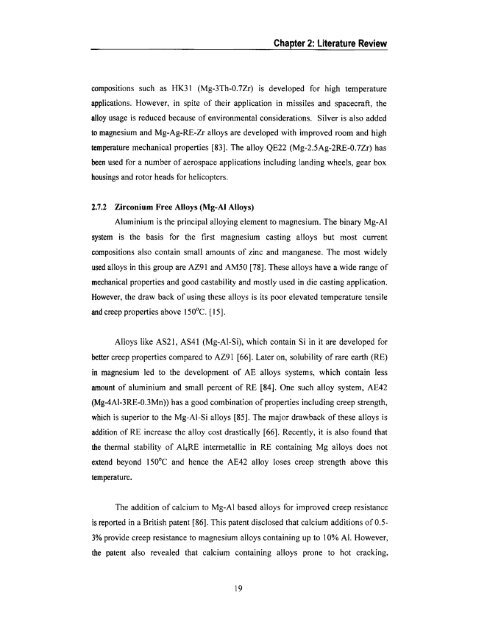“Influence of Si, Sb and Sr Additions on the Microstructure ...
“Influence of Si, Sb and Sr Additions on the Microstructure ...
“Influence of Si, Sb and Sr Additions on the Microstructure ...
Create successful ePaper yourself
Turn your PDF publications into a flip-book with our unique Google optimized e-Paper software.
Z g _ U Chapter 2: Literature Review<br />
compositi<strong>on</strong>s such as HK3l (Mg-3Th-0.7Zr) is developed for high temperature<br />
applicati<strong>on</strong>s. However, in spite <str<strong>on</strong>g>of</str<strong>on</strong>g> <strong>the</strong>ir applicati<strong>on</strong> in missiles <str<strong>on</strong>g>and</str<strong>on</strong>g> spacecraft, <strong>the</strong><br />
alloy usage is reduced because <str<strong>on</strong>g>of</str<strong>on</strong>g> envir<strong>on</strong>mental c<strong>on</strong>siderati<strong>on</strong>s. <str<strong>on</strong>g>Si</str<strong>on</strong>g>lver is also added<br />
to magnesium <str<strong>on</strong>g>and</str<strong>on</strong>g> M g-Ag-RE-Zr alloys are developed with improved room <str<strong>on</strong>g>and</str<strong>on</strong>g> high<br />
temperature mechanical properties [83]. The alloy QE22 (Mg-2.5Ag-ZRE-0.7Zr) has<br />
been used for a number <str<strong>on</strong>g>of</str<strong>on</strong>g> aerospace applicati<strong>on</strong>s including l<str<strong>on</strong>g>and</str<strong>on</strong>g>ing wheels, gear box<br />
housings <str<strong>on</strong>g>and</str<strong>on</strong>g> rotor heads for helicopters.<br />
2.7.2 Zirc<strong>on</strong>ium Free Alloys (Mg-Al Alloys)<br />
Aluminium is <strong>the</strong> principal alloying element to magnesium. The binary Mg-Al<br />
system is <strong>the</strong> basis for <strong>the</strong> first magnesium casting alloys but most current<br />
compositi<strong>on</strong>s also c<strong>on</strong>tain small amounts <str<strong>on</strong>g>of</str<strong>on</strong>g> zinc <str<strong>on</strong>g>and</str<strong>on</strong>g> manganese. The most widely<br />
used alloys in this group are AZ9l <str<strong>on</strong>g>and</str<strong>on</strong>g> AM50 [78]. These alloys have a wide range <str<strong>on</strong>g>of</str<strong>on</strong>g><br />
mechanical properties <str<strong>on</strong>g>and</str<strong>on</strong>g> good castability <str<strong>on</strong>g>and</str<strong>on</strong>g> mostly used in die casting applicati<strong>on</strong>.<br />
However, <strong>the</strong> draw back <str<strong>on</strong>g>of</str<strong>on</strong>g> using <strong>the</strong>se alloys is its poor elevated temperature tensile<br />
<str<strong>on</strong>g>and</str<strong>on</strong>g> creep properties above 150°C. [l5].<br />
Alloys like AS2l, AS41 (Mg-Al-<str<strong>on</strong>g>Si</str<strong>on</strong>g>), which c<strong>on</strong>tain <str<strong>on</strong>g>Si</str<strong>on</strong>g> in it are developed for<br />
better creep properties compared to AZ9l [66]. Later <strong>on</strong>, solubility <str<strong>on</strong>g>of</str<strong>on</strong>g> rare earth (RE)<br />
in magnesium led to <strong>the</strong> development <str<strong>on</strong>g>of</str<strong>on</strong>g> AE alloys systems, which c<strong>on</strong>tain less<br />
amount <str<strong>on</strong>g>of</str<strong>on</strong>g> aluminium <str<strong>on</strong>g>and</str<strong>on</strong>g> small percent <str<strong>on</strong>g>of</str<strong>on</strong>g> RE [84]. One such alloy system, AE42<br />
(Mg-4Al-3RE-0.3Mn)) has a good combinati<strong>on</strong> <str<strong>on</strong>g>of</str<strong>on</strong>g> properties including creep strength,<br />
which is superior to <strong>the</strong> Mg-Al-<str<strong>on</strong>g>Si</str<strong>on</strong>g> alloys [85]. The major drawback <str<strong>on</strong>g>of</str<strong>on</strong>g> <strong>the</strong>se alloys is<br />
additi<strong>on</strong> <str<strong>on</strong>g>of</str<strong>on</strong>g> RE increase <strong>the</strong> alloy cost drastically [66]. Recently, it is also found that<br />
<strong>the</strong> <strong>the</strong>rmal stability <str<strong>on</strong>g>of</str<strong>on</strong>g> Al4RE intermetallic in RE c<strong>on</strong>taining Mg alloys does not<br />
extend bey<strong>on</strong>d 150°C <str<strong>on</strong>g>and</str<strong>on</strong>g> hence <strong>the</strong> AE42 alloy loses creep strength above this<br />
temperature.<br />
The additi<strong>on</strong> <str<strong>on</strong>g>of</str<strong>on</strong>g> calcium to Mg-Al based alloys for improved creep resistance<br />
is reported in a British patent [86]. This patent disclosed that calcium additi<strong>on</strong>s <str<strong>on</strong>g>of</str<strong>on</strong>g> 0.5<br />
3% provide creep resistance to magnesium alloys c<strong>on</strong>taining up to l0% Al. However,<br />
<strong>the</strong> patent also revealed that calcium c<strong>on</strong>taining alloys pr<strong>on</strong>e to hot cracking.<br />
l9
















